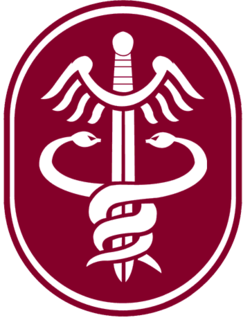Software & Hardware
MC4 is a (semi-) ruggedized system-of-systems containing medical software packages fielded to operational medical forces worldwide. The MC4 PMO provides Army-specific infrastructure (MC4 system) to support deployment of the Defense Health Information Management System (DHIMS), Theater Medical Information Program-Joint (TMIP-J) products. The TMIP-J applications include software for electronic medical record (EMR) documentation, a web-based application that serves as a deployed EMR repository and a web-based application for conducting battlefield surveillance.
Although the MC4 program doesn't create the software, the MC4 program does provide the tools needed to digitally record and transfer critical medical data from the foxhole to medical treatment facilities around the world.
MC4 is more than an EMR. The MC4 system is the Army's tactical medical information system including software from multiple sources, future systems and applications, package fielding and technical support.
Deployable medical forces use the MC4 system to gain quick, accurate access to patient histories and forward casualty resuscitation information. The system also provides automated tools facilitating patient and item tracking, blood management, medical reporting and medical logistical support.
Training, Fielding & Support
MC4 provides new equipment training while Unit Commanders are responsible for sustainment training. MC4 is always looking at new ways to provide training that aligns with its charter and resources.
First deployed in 2003, MC4 has fielded systems to tactical medical units throughout Iraq, Kuwait, Qatar and Afghanistan, making it the most comprehensive information management/information technology medical system deployed to date.
MC4 support personnel assure system sustainability.
This commitment is supported by regional support centers in the U.S., South Korea, Europe, Kuwait, and currently Afghanistan as well as a 24-7, online helpdesk, providing a worldwide sustainment and technical support structure.

Communications security is the discipline of preventing unauthorized interceptors from accessing telecommunications in an intelligible form, while still delivering content to the intended recipients.

The U.S. Army Medical Command (MEDCOM) is a direct reporting unit of the U.S. Army that formerly provided command and control of the Army's fixed-facility medical, dental, and veterinary treatment facilities, providing preventive care, medical research and development and training institutions. On 1 October 2019, operational and administrative control of all military and veteran medical facilities transitioned to the Defense Health Agency.

An electronic health record (EHR) is the systematized collection of patient and population electronically stored health information in a digital format. These records can be shared across different health care settings. Records are shared through network-connected, enterprise-wide information systems or other information networks and exchanges. EHRs may include a range of data, including demographics, medical history, medication and allergies, immunization status, laboratory test results, radiology images, vital signs, personal statistics like age and weight, and billing information.
Medical practice management software (PMS) is a category of healthcare software that deals with the day-to-day operations of a medical practice including veterinarians. Such software frequently allows users to capture patient demographics, schedule appointments, maintain lists of insurance payors, perform billing tasks, and generate reports.

The Combat Capabilities Development Command (CCDC) C5ISR Center, formerly the Communications-Electronics RD&E Center (CERDEC), is the United States Army information technologies and integrated systems center. CCDC C5ISR Center is headquartered at Aberdeen Proving Ground in Maryland, with activities at Fort Belvoir in Virginia and Joint Base McGuire-Dix-Lakehurst in New Jersey.

OpenEMR is a medical practice management software which also supports Electronic Medical Records (EMR). It is ONC Complete Ambulatory EHR certified and it features fully integrated electronic medical records, practice management for a medical practice, scheduling, and electronic billing.
OSCAR McMaster is a web-based electronic medical record (EMR) system initially developed for academic primary care clinics. It has grown into a comprehensive EMR and billing system used by many doctor's offices and private medical clinics in Canada and other parts of the world. The name is derived from where it was created and an acronym; OSCAR stands for Open Source Clinical Application and Resource and McMaster refers to McMaster University, where it was developed. It enables the delivery of evidence resources at the point of care.

OpenMRS is a collaborative open-source project to develop software to support the delivery of health care in developing countries.

The 528th Sustainment Brigade (Airborne), 528th Sustainment Brigade (SO) (A), or 528th SB (SO) (A) was activated on 16 December 2008, as part of the overall United States Army Special Operations Forces logistics transformation. The brigade replaced the Special Operations Support Command (Airborne) (SOSCOM) as combat service support and combat health support unit for all Army Special Operations Command (USASOC) units under the 1st Special Forces Command (Airborne).

First Databank (FDB) is a major provider of drug and medical device databases that help inform healthcare professionals to make decisions. FDB partners with information system developers to deliver useful medication- and medical device-related information to clinicians, business associates, and patients. FDB is part of Hearst and the Hearst Health network.
The 1st Close Health Battalion (1CHB) is a unit of the 17th Sustainment Brigade of the Australian Army. It is headquartered at the Robertson Army Barracks in Darwin, but has sub-units located in Darwin, Townsville and Brisbane. The unit traces its lineage back to the 1st Field Hospital, which was raised in the 1960s for service as part of Australia's contribution to the Vietnam War. Since then, the unit has changed names twice and personnel have been deployed on numerous peacekeeping and warlike operations throughout Africa, the Middle East and the Asia-Pacific region.
ClearHealth is an open-source practice management (PM) and electronic medical records (EMR/EHR/PHR) system available under the GNU General Public License.
Health information technology (HIT) is health technology, particularly information technology, applied to health and health care. It supports health information management across computerized systems and the secure exchange of health information between consumers, providers, payers, and quality monitors. Based on an often-cited 2008 report on a small series of studies conducted at four sites that provide ambulatory care – three U.S. medical centers and one in the Netherlands – the use of electronic health records (EHRs) was viewed as the most promising tool for improving the overall quality, safety and efficiency of the health delivery system. According to a 2006 report by the Agency for Healthcare Research and Quality, in an ideal world, broad and consistent utilization of HIT would:

The Veterans Health Information Systems and Technology Architecture (VISTA) is a health information system deployed across all veteran care sites in the United States. VISTA provides clinical, administrative, and financial functions for all of the 1700+ hospitals and clinics of the Veterans Health Administration VISTA consists of 180 clinical, financial, and administrative applications integrated within a single transactional database.
AHLTA is a global Electronic Health Record (EHR) system used by U.S. Department of Defense (DoD). It was implemented at Army, Navy and Air Force Military Treatment Facilities (MTF) around the world between January 2003 and January 2006. It is a services-wide medical and dental information management system. What made AHLTA unique was its implementation date, its Central Data Repository, its use in operational medicine and its global implementation. There is nothing like it in the private sector.
Clinical point of care (POC) is the point in time when clinicians deliver healthcare products and services to patients at the time of care.

The 274th Forward Surgical Team (Airborne)—part of the 274th Forward Resuscitative and Surgical Detachment (Airborne)—is an airborne forward surgical team of the United States Army providing Level II care far forward on the battlefield. It was first constituted in 1944 and served in Europe during World War II. More recently it has been involved in relief operations following natural disasters and has undertaken several recent deployments to Iraq and Afghanistan. The 274th Forward Surgical Team was part of both the initial entry forces of Operation Enduring Freedom in 2001 and Operation Iraqi Freedom in 2003. Currently the unit falls under the command of the 28th Combat Support Hospital and is based at Fort Bragg, North Carolina.
Home health care software sometimes referred to as home care software or home health software falls under the broad category of health care information technology (HIT). HIT is “the application of information processing involving both computer hardware and software that deals with the storage, retrieval, sharing, and use of health care information, data, and knowledge for communication and decision making” Home health software is designed specifically for companies employing home health providers, as well as government entities who track payments to home health care providers.
Federal and state governments, insurance companies and other large medical institutions are heavily promoting the adoption of electronic health records. The US Congress included a formula of both incentives and penalties for EMR/EHR adoption versus continued use of paper records as part of the Health Information Technology for Economic and Clinical Health (HITECH) Act, enacted as part of the, American Recovery and Reinvestment Act of 2009.









